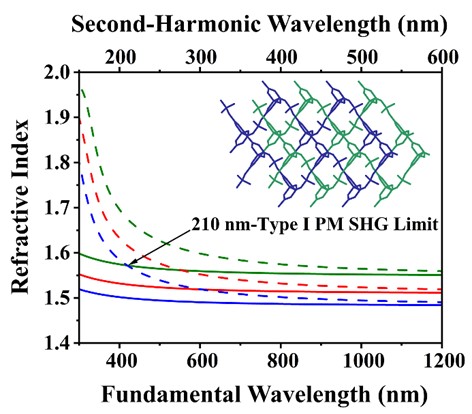Researchers synthesize a promising UV NLO crystal having fluorine-directed optimal performances and double interpenetrating 3[B6O9F2]∞ networks
Editor: | Feb 13,2023
A long-lasting challenge in ultraviolet (UV) nonlinear optical (NLO) materials design is to combine conflicting and harsh properties into one structure, including wide UV transparency, strong NLO efficiency, and moderate birefringence to realize phase-matching at short wavelength. A fluorine-directed material design strategy is adopted to accelerate the process of finding NLO materials with excellent performances.
Recently, researchers of Research Center for Crystal Materials successfully synthesized a UV NLO crystal, LiNaB6O9F2 by adopting the fluorine-directed material design strategy. LiNaB6O9F2 possesses novel double interpenetrating 3[B6O9F2]∞ networks composed of [B6O11F2] fundamental building blocks (FBBs). Experimental characterization and numerical computation results indicate that LiNaB6O9F2 exhibits excellent UV NLO performances, including deep-UV cutoff edge, large SHG responses (1.1× KDP at 1064 nm) and moderate birefringence (0.067 at 1064 nm). It is noteworthy that with the introduction of fluorine, LiNaB6O9F2 exhibits the fluorine-directed optimal performances including a larger birefringence (0.067 at 1064 nm) than that of LBO (0.040 at 1064 nm), and a blue-shifted phase-matching SHG wavelength (210 nm) compared with that of LBO (277 nm). This work enriches the structural chemistry of fluorooxoborates and proves that the fluorine-directed strategy is a feasible method to explore NLO crystals with excellent optical performances.
This work was published in Advanced Optical Materials as a Research Article (Adv. Optical Mater. 2023, 11, 2202195).
This work was supported by the National Natural Science Foundation of China (61835014, 51972336, 61922084), the West Light Foundation of CAS (2020-JCTD-002), the Instrument Developing Project of CAS (GJJSTD20200007), the Xinjiang Major Science and Technology Project (2021A01001), and the National Key R&D Program of China (2021YFB3601502). The authors gratefully acknowledge the reviewers for their valuable comments and suggestions, which are beneficial to improving the manuscript.
Article:https://doi.org/10.1002/adom.202202195

附件下载:
 (86) 991-3838931
(86) 991-3838931 lhskj@ms.xjb.ac.cn
lhskj@ms.xjb.ac.cn (86)991-3838957
(86)991-3838957 40-1 Beijing Road
Urumqi, XinjiangChina
40-1 Beijing Road
Urumqi, XinjiangChina